
American Impressionist Artist: Mary Cassatt (Ca-SAHT) (1844-1926)
Aquatint Etching: Drypoint with soft-ground etching, á la poupée technique.
Untitled but known as: “Mother and Child” or "Little Ann Sucking Her Finger".
Signed In pencil: “Mary Cassatt” lower right.
Image Size: 8.5in. x 10.25in. (21.5 cm. x 26 cm.) inked sight size.
Sheet Size: 10.1/8in. x 13.1/16in. (25.7 cm. x 33.1 cm.)
Edition Number: Known to be from a series of 25 impressions.
Condition: Clean and colourful, a very rich impression with fresh colors.
Date of Creation: Circa 1897, impressed on handmade buff colour wove paper.
Framed Size: 15.5in. x 18.75in. (29cm. x 48cm.)
Framing Materials: Acid free, rag content throughout. Glass silicone set.
Authentication: This fine aquatint by Mary Cassatt is guaranteed to be 100% original, authentic and hand-pulled by the artist on her etching press in France.
A Special Note of Interest: A dedicated artist and printmaker, Mary Cassatt produced more than two hundred aquatints, etchings, drypoints, and lithographs over a period of thirty years. The wonderful aquatint etching shown here is considered to be among some of her finest works, created when she was at the peak of her printmaking career. Although there is no print number notation, this aquatint is known to be from an edition of 25 impressions. Mary devoted as much time as was necessary to satisfy her eye when colouring the etching plate with all of its constituent palette of shades and toning. Then, and only then, after careful deliberation would it be ready for the final impression on the etching press.
À la poupée is a time consuming, historic intaglio printmaking technique for making colour prints by applying different ink colours to a single printing plate. The coloured plate would then make just one run through the press to create the final aquatint print. After each impression was printed the plate would be cleaned and the colouring process would begin once again.
The term à la poupée means "with the doll" in French, the "doll" being a wad of cloth, shaped like a ball.
Mary Cassatt used sticks fitted with soft round cloth-covered heads to apply coloured inks directly to the surface of the plate. Because she hand-colored the etched plate individually, each printing can and does vary at least slightly, and sometimes more significantly. Every impression in this edition can be acknowledged as a unique work of art, with each possessing slightly different tonal colour variations and itensities.
This fine condition hand-pulled aquatint is based upon Mary Cassatt's pastel creation entitled Maternité, or 'Mère et enfant sur fond vert', 'Mother and child on gold green background' of 1897, which is in the collection of the Musee d'Orsay, Paris.
Mary Stevenson Cassatt American Impressionist Artist and Printmaker
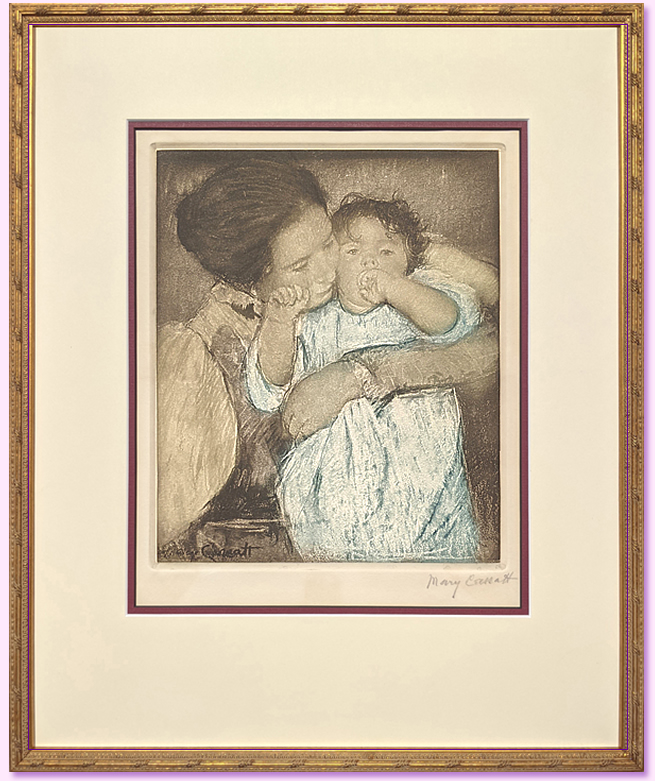
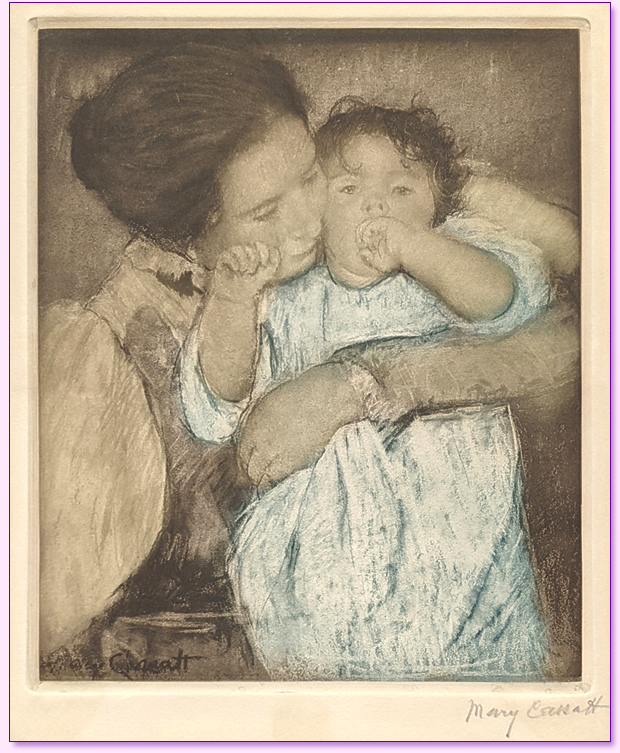
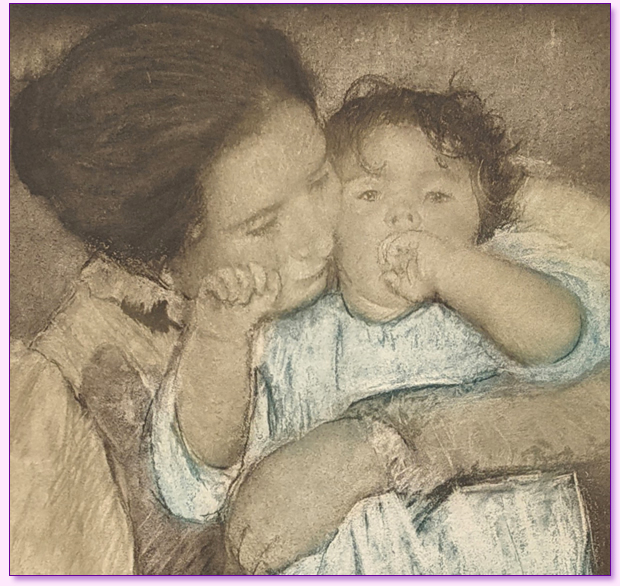
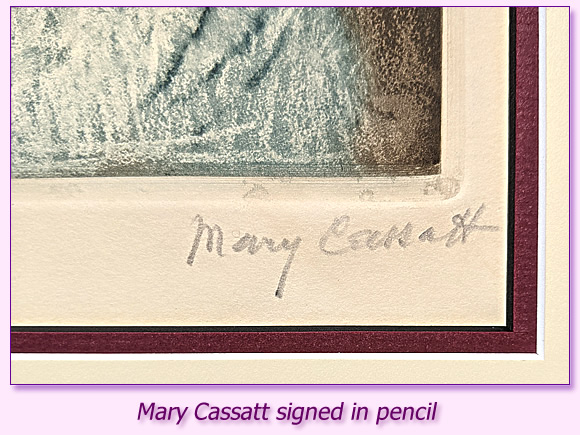
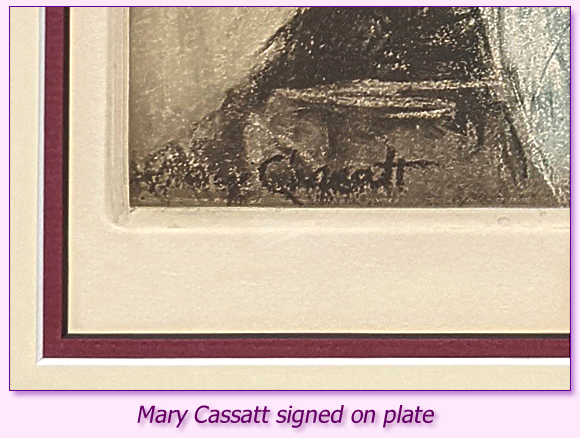
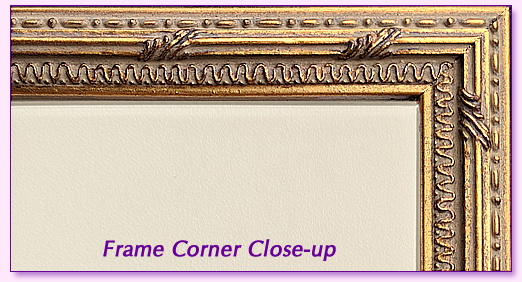
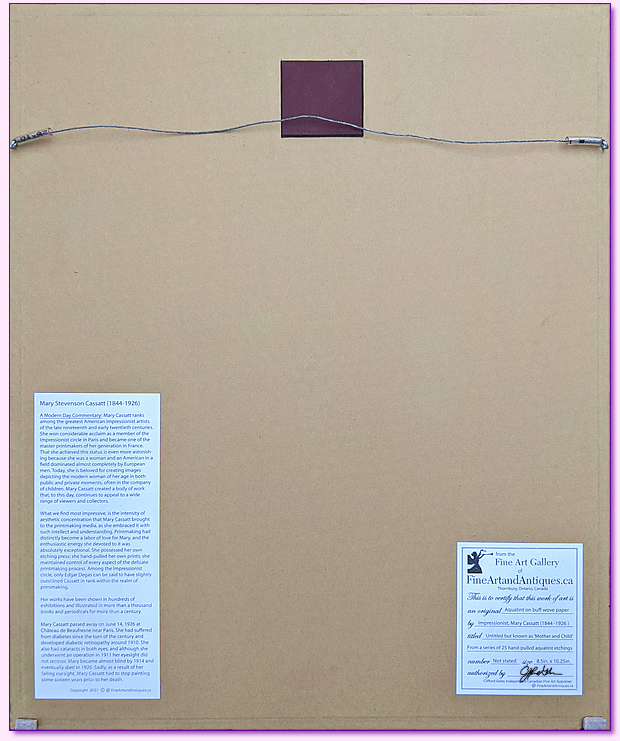
![]()
![]()
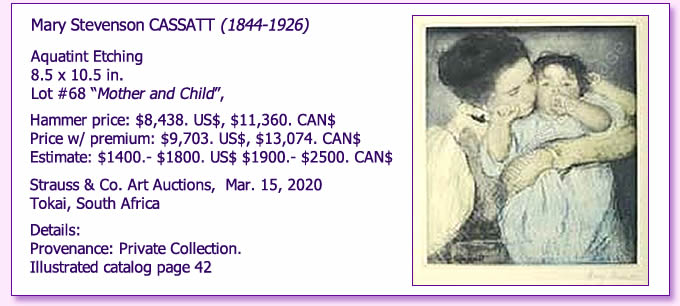
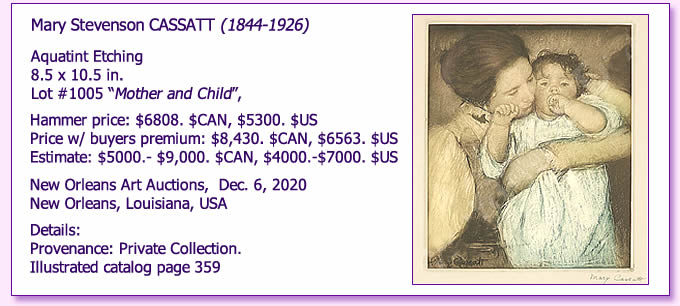
![]()
![]()
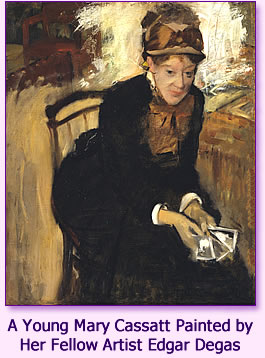 Her Early Life:
Mary Stevenson Cassatt was born into a family of wealth through her parents, Robert Simpson Cassatt and Katherine Kelso Johnston. Robert was a land speculator and a stockbroker, while Katherine came from a banking family. Robert and Katherine bore seven children but lost two of theirs in infancy. The family lived in the United States then decided to move to France, but after a short time there they relocated to Germany. They moved to Germany so that one son could study engineering there. While still in France, Mary was inspired by French artists such as Corot and Ingres. She likely met these artists as a child at the Paris World's Fair of 1855. That year, Cassatt would later return to the USA to study fine arts. By the time she returned to the USA, she was partly fluent in both French and German.
Her Early Life:
Mary Stevenson Cassatt was born into a family of wealth through her parents, Robert Simpson Cassatt and Katherine Kelso Johnston. Robert was a land speculator and a stockbroker, while Katherine came from a banking family. Robert and Katherine bore seven children but lost two of theirs in infancy. The family lived in the United States then decided to move to France, but after a short time there they relocated to Germany. They moved to Germany so that one son could study engineering there. While still in France, Mary was inspired by French artists such as Corot and Ingres. She likely met these artists as a child at the Paris World's Fair of 1855. That year, Cassatt would later return to the USA to study fine arts. By the time she returned to the USA, she was partly fluent in both French and German.
Early Art Training: Her father objected to the idea of Mary studying fine arts at the Pennsylvania Academy of the Arts. During this period, feminism was emerging and her father may have wanted his daughter to not embrace this ideology. Feminism fought for the inclusion of female children in schools. Boys pursuing higher learning was prioritized more than the education of the female child during this era. It’s known that twenty percent of the girls in her class were fine arts students and those numbers were on the rise. Cassatt later lost patience with her teachers at the Pennsylvania Academy, who were predominantly male, plus she observed that the teachers taught in a very slow patronizing way. Due to the methods used by the teachers who were instructing her, she decided to end her art studies there.
Her Travels around: In 1866 Mary decided to move to Paris to pursue her passion for the fine arts. Needless to say, her father still objected to her decision. Despite his objections, she successfully moved to Paris with her mother and some family friends. In Paris, women were not allowed to study at the Ecole des Beaux-Arts institution, so Cassatt was forced to enroll in a Master's program at the school privately. Her instructors were so impressed with her painting skills and a highly regarded teacher was assigned to work with her. The teacher's name was Jean-Léon Gérôme. He was known for painting exotic and sometimes scandalous paintings. However, people in-the-know highly regarded his ability to delve deeply into the details of a painting and these talents could aid Mary.
Still, in 1866, she joined another painting class taught by Charles Chaplin; a genre artist. In 1868, she met an art student called Thomas Couture. Thomas specialized in urban and romantic art. Both of them would travel to the countryside to get inspiration for their artwork. Their paintings mainly focused on peasants going about their usual activities. Later in 1866, she eventually got her big break when one of her paintings was accepted by a jury for the Paris Salon. This painting was named 'A Mandoline Player', which depicted a young girl playing the mandolin against a dark background. Around this time, many French artists tried to challenge some notions regarding art, when they advocated for an individual to paint as they felt like, rather than letting the academics dictate their preferred painting style.
In 1870, she returned to the USA at the height of the Franco-Prussia War. Her father paid for her basic needs while in the country but refused to support her art supplies. She had brought with her two paintings. Cassatt placed her paintings in a New York gallery and many people appeared to admire her paintings, but none of them were purchased. In 1871, she almost gave up on art to consider another different job entirely. However, she decided to travel to Chicago to try her luck once again with her paintings. Unfortunately, tragedy struck when some of her paintings were destroyed during the Great Chicago Fire of 1871. A few months later, an archbishop from Pittsburgh was amazed by her works. He commissioned her to create paintings and she was able to pay for her stay in the USA and still continue to paint.
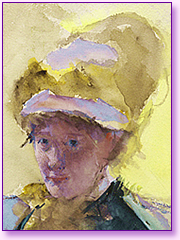 Mary Cassatt's Career Developed:
In 1871, she returned to Europe. The following year, her painting of, "Two Women Throwing Flowers during Carnival," was well received in the Salon and subsequently purchased. She was one of the first American artists, along with William Merritt Chase, to paint in an impressionistic mode. In Italy, she received the support and encouragement of the art community and she was finally finding her confidence. She travelled from Italy to Spain. In Spain, she created very many new paintings. In 1873, she made an infamous painting titled, "Spanish Dancer Wearing a Lace Mantilla." The painting, today, is at the National Museum of American Art, at the Smithsonian Institution. In 1874, she took up residence in France and her sister Lydia joined her. In France, Mary had become overly critical of the Salon art politics. She criticized the Salon's prioritization of modern art over independent art. In 1875, she noticed her painting was only approved once she painted a dark background in it. She noted that the artist did not have the freedom to paint as they wished. Also, she noticed that women's paintings were automatically dismissed.
Mary Cassatt's Career Developed:
In 1871, she returned to Europe. The following year, her painting of, "Two Women Throwing Flowers during Carnival," was well received in the Salon and subsequently purchased. She was one of the first American artists, along with William Merritt Chase, to paint in an impressionistic mode. In Italy, she received the support and encouragement of the art community and she was finally finding her confidence. She travelled from Italy to Spain. In Spain, she created very many new paintings. In 1873, she made an infamous painting titled, "Spanish Dancer Wearing a Lace Mantilla." The painting, today, is at the National Museum of American Art, at the Smithsonian Institution. In 1874, she took up residence in France and her sister Lydia joined her. In France, Mary had become overly critical of the Salon art politics. She criticized the Salon's prioritization of modern art over independent art. In 1875, she noticed her painting was only approved once she painted a dark background in it. She noted that the artist did not have the freedom to paint as they wished. Also, she noticed that women's paintings were automatically dismissed.
In 1877, her entries were rejected by the Salon. During this challenging time in her career, she met a painter called Edgar Degas. Edgar was part of a group called, "The Impressionists," or "The Independents." This group preferred open painting, something critics did not take kindly. Apart from critics viewing the group as painting arbitrary paintings, they were also considered radical in their cause. Also in 1877, her parents and her sister Lydia joined her in Paris and she valued their companionship. To concentrate fully on her passion, she put aside the idea of marriage, as she felt it would interfere with her profession. She would frequently paint her sister up until her death, but Lydia's passing devastated Mary and she did not put up any paintings for a while.
By 1879, she officially joined the group's cause after learning that Edgar's paintings had been displayed at an art dealer's window. She also admired his pastels. Cassatt hoped for commercial success after selling her paintings to Parisians, who were considered somewhat sophisticated. The Impressionist exhibit of 1879 was the most successful event to date. Each member of the club made a profit. Despite the success, the group was still criticized. Degas trained her on how to use pastels and the art of copper engraving. They worked together for a while and she remained active in the group until 1886. As of that year, eleven of her works were displayed in art galleries.
Her Passing:
Mary Cassatt passed away on June 14, 1926 at Château de Beaufresne near Paris. She had suffered from diabetes since the turn of the century and developed diabetic retinopathy around 1910. She also had cataracts in both eyes, and although she underwent an operation in 1911 her eyesight did not recover. Mary ceased printmaking in 1901, followed by painting in 1904 and became almost blind by 1914. Sadly, as a result of her failing eyesight, she had to stop painting some dozen or so years prior to her death.
![]()
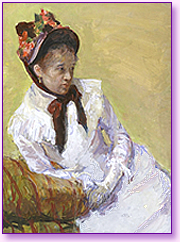 A Modern Day Commentary:
Mary Cassatt ranks among the greatest American impressionist artists of the late nineteenth and early twentieth centuries. She won considerable acclaim as a member of the Impressionist circle in Paris and became one of the master printmakers of her generation in France. That she achieved this status is even more astonishing because she was a woman and an American in a field dominated almost completely by European men. Today, she is beloved for creating images depicting the modern woman of her age in both public and private moments, often in the company of children. Mary Cassatt created a body of work that, to this day, continues to appeal to a wide range of viewers and aficionados.
A Modern Day Commentary:
Mary Cassatt ranks among the greatest American impressionist artists of the late nineteenth and early twentieth centuries. She won considerable acclaim as a member of the Impressionist circle in Paris and became one of the master printmakers of her generation in France. That she achieved this status is even more astonishing because she was a woman and an American in a field dominated almost completely by European men. Today, she is beloved for creating images depicting the modern woman of her age in both public and private moments, often in the company of children. Mary Cassatt created a body of work that, to this day, continues to appeal to a wide range of viewers and aficionados.
What we find most impressive, is the intensity of aesthetic concentration that Mary Cassatt brought to the printmaking media, as she embraced it with such intellect and understanding. Printmaking had distinctly become a labor of love for Mary, and the enthusiastic energy she devoted to it was absolutely exceptional. She possessed her own etching press and hand-pulled all of her prints, plus she maintained control of every aspect of the delicate printmaking process. Among her Impressionist circle of printmaking friends, only Edgar Degas can be said to have just slightly outshined Cassatt in rank.
Another Note of Interest: Her paintings and prints, most of them created while living in France, are now found in the collections of astute individuals and notable institutions from San Francisco to Moscow. Her works have been shown in hundreds of exhibitions and illustrated in more than a thousand books and periodicals for more than a century. In October 2020, Mary Cassatt's artworks are still a potent force in the art world, as one of her oil paintings sold at Sotheby's
New York art auction for the sum of $4.3 million AM$.
![]()
Google's Chrome browser regaled us with an homage to Mary Stevenson Cassatt and her impressionist style in 2009, by creating a pastiche of Mary's 1893 masterwork, 'The Child’s Bath' in one of their daily online 'doodles'. It was displayed on her birthday, the 22nd of May. Today, the original painting that Google's rendition was taken from can be viewed in the collection of the Art Institute of Chicago.
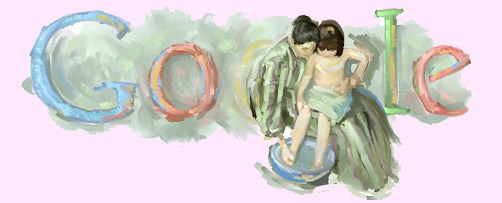
Print Ref No: 521XTTITWDD-S/TAOEEX
Mary Stevenson Cassatt American Impressionist Artist and Printmaker
Updated February 27, 2025 |
|
|---|



